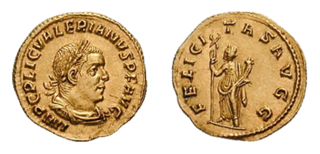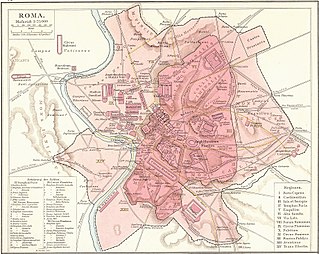Related Research Articles

Livia Drusilla was Roman empress from 27 BC to AD 14 as the wife of Emperor Augustus. She was known as Julia Augusta after her formal adoption into the Julian family in 14 BC.

In ancient Roman religion, Ceres was a goddess of agriculture, grain crops, fertility and motherly relationships. She was originally the central deity in Rome's so-called plebeian or Aventine Triad, then was paired with her daughter Proserpina in what Romans described as "the Greek rites of Ceres". Her seven-day April festival of Cerealia included the popular Ludi Ceriales. She was also honoured in the May lustratio of the fields at the Ambarvalia festival, at harvest-time, and during Roman marriages and funeral rites. She is usually depicted as a mature woman.
Juventas, also known as Iuventus or Juventus (Greek equivalent: Hebe), was the ancient Roman goddess whose sphere of tutelage was youth and rejuvenation. She was especially the goddess of young men "new to wearing the toga" (dea novorum togatorum)—that is, those who had just come of age.
In ancient Roman religion, Aeternitas was the divine personification of eternity. She was particularly associated with Imperial cult as a virtue of the deified emperor (divus). The religious maintenance of abstract deities such as Aeternitas was characteristic of official Roman cult from the time of the Julio-Claudians to the Severans.
Bonus Eventus was a divine personification in ancient Roman religion. The Late Republican scholar Varro lists him as one of the twelve deities who presided over agriculture, paired with Lympha, the goddess who influenced the water supply. The original function of Bonus Eventus may have been agricultural, but during the Imperial era, he represents a more general concept of success and was among the numerous abstractions who appeared as icons on Roman coins.

In ancient Roman culture, felicitas is a condition of divinely inspired productivity, blessedness, or happiness. Felicitas could encompass both a woman's fertility and a general's luck or good fortune. The divine personification of Felicitas was cultivated as a goddess. Although felicitas may be translated as "good luck," and the goddess Felicitas shares some characteristics and attributes with Fortuna, the two were distinguished in Roman religion. Fortuna was unpredictable and her effects could be negative, as the existence of an altar to Mala Fortuna acknowledges. Felicitas, however, always had a positive significance. She appears with several epithets that focus on aspects of her divine power.

In ancient Roman culture, liberalitas was the virtue of giving freely, hence generosity. On coins, a political leader of the Roman Republic or an emperor of the Imperial era might be depicted as displaying largess to the Roman people, with liberalitas embodied as a goddess at his side. The goddess Liberalitas appears on coinage issued under the emperors Gordian III Trajan, Antoninus Pius and Septimius Severus, sometimes designated as Augusta or Augusti in association with Imperial cult. On one example, a Roman holds out his toga to receive coins poured by Liberalitas, as Antoninus looks on from an elevated seat.

Pietas, translated variously as "duty", "religiosity" or "religious behavior", "loyalty", "devotion", or "filial piety", was one of the chief virtues among the ancient Romans. It was the distinguishing virtue of the founding hero Aeneas, who is often given the adjectival epithet pius ("religious") throughout Virgil's epic Aeneid. The sacred nature of pietas was embodied by the divine personification Pietas, a goddess often pictured on Roman coins. The Greek equivalent is eusebeia (εὐσέβεια).
In ancient Roman religion, Spes was the goddess of hope. Multiple temples to Spes are known, and inscriptions indicate that she received private devotion as well as state cult.

In ancient Roman religion, Roma was a female deity who personified the city of Rome and more broadly, the Roman state. She embodied and idealised certain of Rome's ideas about itself, its advancement and its eventual domination of its neighbours. Roman political, moral and religious ideas were portrayed through Roma in different forms: coins, sculptures and architectural designs, even in official games and festivals but seldom in a commonplace or domestic context, as Roma was a construction of Roman state patronage. Though her depictions have been influenced by other goddesses at the time, such as Rome's Minerva, her Greek equivalent Athena and the various manifestations of Greek Tyches, Roma stands out as a symbol of "natural" dominance, with her promise of protection to those who obeyed or cooperated with her, and her "manly virtue" (virtus) as fierce mother of a warrior race.

Religion in ancient Rome includes the ethnic religion of Ancient Rome that the Romans used to define themselves as a people, as well as the religious practices of peoples brought under Roman rule, in so far as they became widely followed in Rome and Italy. The Romans thought of themselves as highly religious, and attributed their success as a world power to their collective piety (pietas) in maintaining good relations with the gods. The Romans are known for the great number of deities they honored, a capacity that earned the mockery of early Christian polemicists.

Pater Patriae, also seen as Parens Patriae, is a Latin honorific meaning "Father of the Country", or more literally, "Father of the Fatherland". It is also used of U.S. President George Washington, the Swedish King Gustav I, Prince Willem of Orange and the four authors of Italian unification Camillo Cavour, Giuseppe Garibaldi, Giuseppe Mazzini and King Victor Emmanuel II.

In ancient Roman religion, Annona is the divine personification of the grain supply to the city of Rome. She is closely connected to the goddess Ceres, with whom she is often depicted in art.

The Roman imperial cult identified emperors and some members of their families with the divinely sanctioned authority (auctoritas) of the Roman State. Its framework was based on Roman and Greek precedents, and was formulated during the early Principate of Augustus. It was rapidly established throughout the Empire and its provinces, with marked local variations in its reception and expression.

The Temple of Divus Augustus was a major temple originally built to commemorate the deified first Roman emperor, Augustus. It was built between the Palatine and Capitoline Hills, behind the Basilica Julia, on the site of the house that Augustus had inhabited before he entered public life in the mid-1st century BC. It is known from Roman coinage that the temple was originally built to an Ionic hexastyle design. However, its size, physical proportions and exact site are unknown. Provincial temples of Augustus, such as the much smaller Temple of Augustus in Pula, now in Croatia, had already been constructed during his lifetime. Probably because of popular resistance to the notion, he was not officially deified in Rome until after his death, when a temple at Nola in Campania, where he died, seems to have been begun. Subsequently, temples were dedicated to him all over the Roman Empire.

Tutela was the ancient Roman concept of "guardianship", conceived of as a goddess in the Imperial period, and from the earliest period as a functional role that various tutelary deities might play, particularly Juno. Tutela had particular applications in Roman law.

Augustus was an ancient Roman title given as both name and title to Gaius Julius Caesar Octavianus, Rome's first Emperor. On his death, it became an official title of his successor, and was so used by Roman emperors thereafter. The feminine form Augusta was used for Roman empresses and other female members of the Imperial family. The masculine and feminine forms originated in the time of the Roman Republic, in connection with things considered divine or sacred in traditional Roman religion. Their use as titles for major and minor Roman deities of the Empire associated the Imperial system and Imperial family with traditional Roman virtues and the divine will, and may be considered a feature of the Roman Imperial cult.

Lady Justice is an allegorical personification of the moral force in judicial systems. Her attributes are a blindfold, scales, and a sword. She often appears as a pair with Prudentia.

In ancient Rome, the pompa circensis was the procession that preceded the official games (ludi) held in the circus as part of religious festivals and other occasions.

Fortuna Redux was a form of the goddess Fortuna in the Roman Empire who oversaw a return, as from a long or perilous journey. Her attributes were Fortuna's typical cornucopia, with her specific function represented by a rudder or steering oar sometimes in conjunction with a globe.
References
- ↑ J. Rufus Fears, "The Cult of Virtues and Roman Imperial Ideology," Aufstieg und Niedergang der römischen Welt II.17.2 (1981), p. 886.
- ↑ Prudentia est rerum bonarum et malarum neutrarumque scientia.
- ↑ Cicero, De Inventione 2.160; Elizabeth Henry, The Vigour of Prophecy: A Study of Vergil's Aeneid (Southern Illinois University Press, 1989), p. 68.
- ↑ Fears, "The Cult of Virtues," pp. 886–887, 891.
- ↑ Fears, "The Cult of Virtues," p. 892.
- ↑ Fears, "The Cult of Virtues," pp. 895, 897.
- ↑ Fears, "The Theology of Victory at Rome: Approaches and Problem," ANRW II.17.2 (1981), p. 813, "The Cult of Virtues," pp. 900, 903, 904, 905, 907.
- ↑ Fears, "The Cult of Virtues," p. 902.